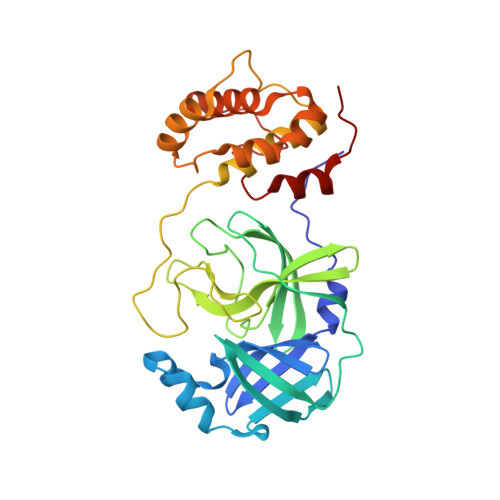Structure-Based Optimization of ML300-Derived, Noncovalent Inhibitors Targeting the Severe Acute Respiratory Syndrome Coronavirus 3CL Protease (SARS-CoV-2 3CL pro ).
Han, S.H., Goins, C.M., Arya, T., Shin, W.J., Maw, J., Hooper, A., Sonawane, D.P., Porter, M.R., Bannister, B.E., Crouch, R.D., Lindsey, A.A., Lakatos, G., Martinez, S.R., Alvarado, J., Akers, W.S., Wang, N.S., Jung, J.U., Macdonald, J.D., Stauffer, S.R.(2022) J Med Chem 65: 2880-2904
- PubMed: 34347470
- DOI: https://doi.org/10.1021/acs.jmedchem.1c00598
- Primary Citation of Related Structures:
7LMD, 7LME, 7LMF, 7LMG, 7LMH, 7LMI, 7LMJ - PubMed Abstract:
Starting from the MLPCN probe compound ML300, a structure-based optimization campaign was initiated against the recent severe acute respiratory syndrome coronavirus (SARS-CoV-2) main protease (3CL pro ). X-ray structures of SARS-CoV-1 and SARS-CoV-2 3CL pro enzymes in complex with multiple ML300-based inhibitors, including the original probe ML300, were obtained and proved instrumental in guiding chemistry toward probe compound 41 (CCF0058981). The disclosed inhibitors utilize a noncovalent mode of action and complex in a noncanonical binding mode not observed by peptidic 3CL pro inhibitors. In vitro DMPK profiling highlights key areas where further optimization in the series is required to obtain useful in vivo probes. Antiviral activity was established using a SARS-CoV-2-infected Vero E6 cell viability assay and a plaque formation assay. Compound 41 demonstrates nanomolar activity in these respective assays, comparable in potency to remdesivir. These findings have implications for antiviral development to combat current and future SARS-like zoonotic coronavirus outbreaks.
Organizational Affiliation:
Center for Therapeutics Discovery, Lerner Research Institute, Cleveland Clinic, Cleveland, Ohio 44195, United States.

















